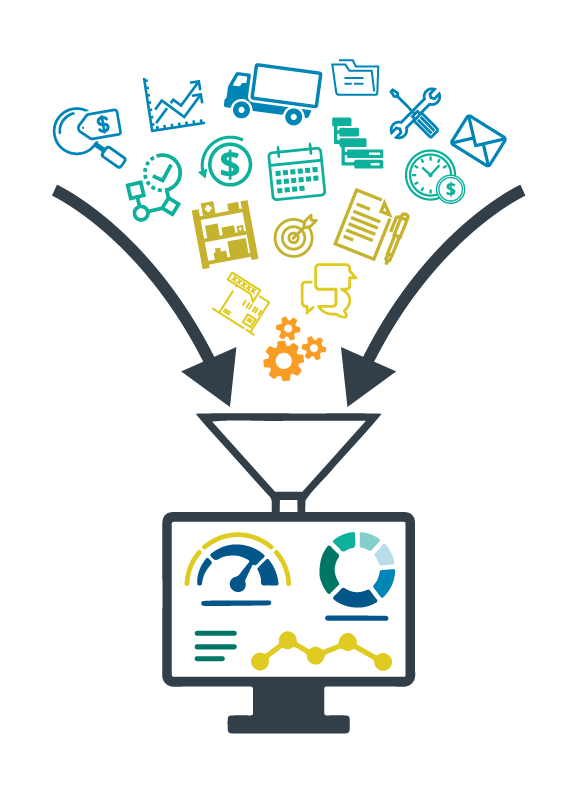
Is your Health System Achieving Clear Spend Visibility? (Spend Visibility Part 2)
August 29, 2022Understanding Healthcare’s Procure to Pay Process
November 30, 2022To truly reap the benefits of spend visibility, health systems must take action to clean, structure, and analyse all procure to pay (P2P) data. Follow the steps outlined below to gain proper visibility at your hospital.
How to Increase Spend Visibility
Step 1: Identify All Sources of Data
 One of the largest challenges hindering health systems from reaching clear spend visibility is the multiple data sources. Identifying all data sources necessary to gain true insight into spend fuels the analysis and decision-making process throughout procure to pay (P2P) processes.
One of the largest challenges hindering health systems from reaching clear spend visibility is the multiple data sources. Identifying all data sources necessary to gain true insight into spend fuels the analysis and decision-making process throughout procure to pay (P2P) processes.
Data Sources for Spend Visibility
- ERP System
- Contracts
- Dark data sources such as email
- GPOs
- Invoices
- Item master
- Log files
- Payments Statements (bank, ACH, credit card, and wire records)
- Purchase Orders
- Statements
- Supplier/vendor Portals
- Vendor master
Step 2: Extract Data and Fill in Missing Information
Once all data sources are determined, a central database should be created housing all information. Essentially, this creates a single source of truth (SSOT) for all data that ends in payment. Having this centralized SSOT allows data to be combined and analyzed to provide complete spend visibility.
Extracting data from multiple systems and departments may require IT or third-party resources to analyze and provide insight for decision-making.
Once the data is in place, missing information must be collected and recorded. To get urgent supplies and pay vendors, health systems often find themselves with incomplete vendor or item data. This may be missing TIN, W-9s, or item price and UOM info.
We can create an SSOT including a contract repository to provide spend visibility to health system leaders allowing them to make decisions around supplier consolidation, category budgets, and more. Contact us to get started now.
Step 3: Classify, Verify and Cleanse Data
Data Classification
After all the data is centralized and completed, health systems should classify their purchases using classification standards such as Universal Standard Products and Services Classification (UNSPSC) and Global Trade Item Number (GTIN). Also, classify items based on your health system or hospital’s custom taxonomy. Using classification standards provides insight into spend, such as similar items being purchased from different vendors or opportunities for item standardization.
We can help classify items using HCPCS and Revenue codes to save time in your revenue cycle operations and increase capture amounts. Reach out for more information on updating your item master now.
Data Verification
Data verification and validation are necessary to obtain clear spend visibility. It also decreases duplicate payments and helps detect potential fraudulent vendors. Data validation occurs upon retrieval of entering of information and ensures input follows pre-determined controls, such as character type and amount in a phone number field. While validation efforts and controls help with data input, data is variable and changes frequently. This variability makes it necessary to verify information on an ongoing basis.
Verifying spend data confirms that data is accurate, consistent, and serves its intended purpose. The verification process highlights elements with erroneous details such as missed characters, incorrect addresses, or invalid entries.
Verification can be done internally when comparing and checking multiple data sets against each other. It can also be done by comparing data to outside sources such as the IRS’ Taxpayer Identification Matching (TIN) Tools and UNSPSC databases.
Cleanse Data
Most third-party data cleanses include the previous steps of consolidating data, filling in missing pieces, classifying data, and verifying it. However, more information can be cleansed by eliminating discrepancies in item descriptions, standardizing nomenclature and abbreviations, and removing out-of-date information.
Step 4: Enhance Data
Enhancing data refers to adding information that provides additional insight into spend data beyond the critical or required data. Often, technology can hold back the addition of helpful information and must be adjusted to allow for the tracking of additional data. For example, ERP systems and item masters are not always set up to hold all important contract terms such as:
- Alternative items/substitutes
- Alternative units of measure (UOM) with accurate pricing
- Contract start and end dates
- Relevant item numbers (e.g., system item number, vendor item number, and manufacturer item number)
- Relevant vendor and manufacturer names and item descriptions
- Vendor account numbers
- Vendor representative contact information
Step 5: Analyze and Take Action
Once spend data is complete, cleansed, and enhanced, it can finally be analyzed to provide the spend visibility needed to make actionable decisions throughout the P2P process.
Discover the benefits of spend visibility for your health system or hospitals now!
Drivers to Increase Your Health System’s Spend Visibility
Reduce Costs. Health systems continue to struggle with the “aftermath” of the COVID-19 pandemic. Due to higher supply costs, increased employee costs, and decreased staffing numbers, the time has never been more critical to save funds by cutting costs. Spend visibility allows leaders to discover where funds are leaked, instances for supplier consolidation, and opportunities for item standardization.
Maintain Contract Compliance. Spend visibility provides insight into contract term compliance and usage. Visibility can answer the following questions:
- Is contract pricing utilized on all transactions?
- Is there a more advantageous tier or price available?
- Are discounts, such as prompt pay or volume discounts, being utilized?
Improve Inventory Management. The need to reduce waste and redundant items by better managing inventory drives health systems to gain better spend visibility. Insight provides leaders with the information needed to make supply decisions such as:
- Correct ordering volume to reduce waste and minimize expired or unused products
- Adjusting automated ordering to appropriate volumes to account for potential seasonal changes and other environmental factors
- Understanding the actual usage of items
Expand the Value of Technology. Without insight into spend data, it becomes impossible to understand and measure the full value of the technology being used or the investment to improve technology in the procure to pay space. Most purchasing and payment systems contain numerous layers of available data, reports, and modules. Staff must invest the time to learn the available technology options such as fields, customization, and storage. Leveraging the right controls and customizations ensures all relevant data is captured, such as additional vendor locations, returned goods tracking, and invoice image storage.
Step 6: Maintain and Automate
Once spend data is organized, completed, enhanced, and analyzed, the focus turns toward maintaining accurate and full data. While proactive maintenance takes resources, much of the work can be done by adopting automation and using third parties.
Suggestions for Maintaining Spend Visibility
- Create and enforce processes and training for data input and updates.
- Retrain employees on procedures and policies around data entry and maintenance annually to reinforce correct usage.
- Utilize analysis tools such as Microsoft’s Power Bi to automate reporting and centralize data from multiple sources.
- Use third parties to cleanse and standardize vendor and item masters regularly.
- Routinely utilize Internal Audit or third parties to do a P2P audit to review and renew processes and data from an unbiased source.
- Adopt imaging software to automate data entry and improve record storage.
- to capture complete information moving forward, and create new processes that require the insertion of missing data.
- Move tasks resulting in dark data to more visible systems such as moving email approvals to the ERP systems or adopting a workflow system to capture visibility.
- Ensure all important information is captured during invoice processing through EDI, OCR, or manually. Examples of information include account numbers, payment terms, add-on charges (e.g., freight), and tax.
We specialize in providing P2P analysis, recoveries, and risk assessment to provide health systems accurate and clear spend visibility to make better and informed decisions. Reach out to learn more about how we can help now.



